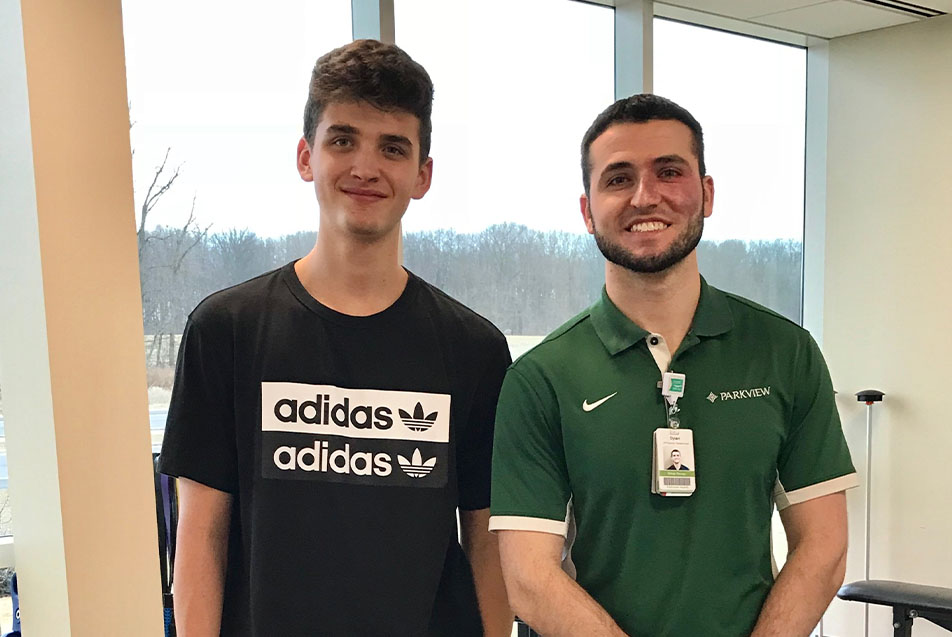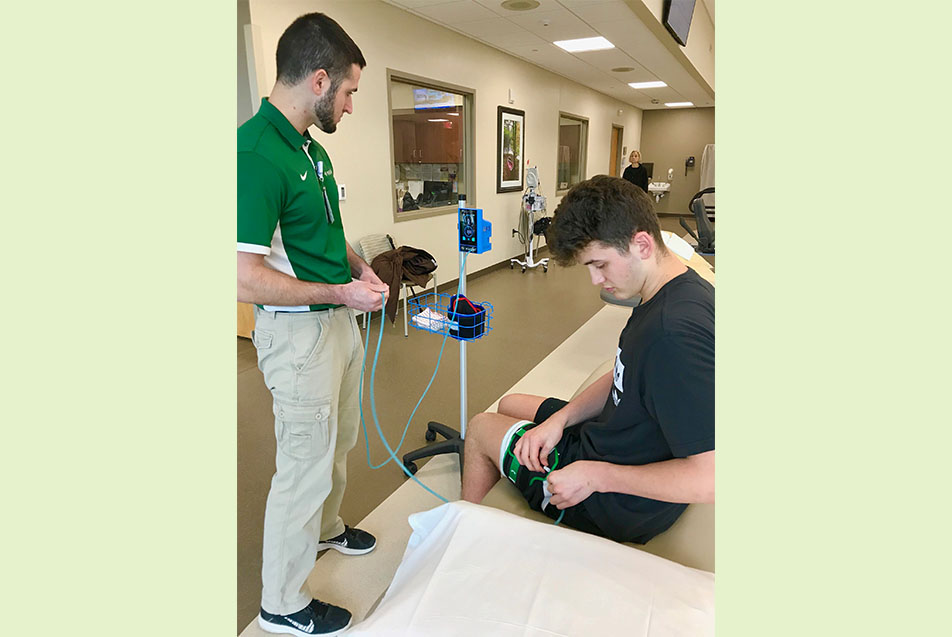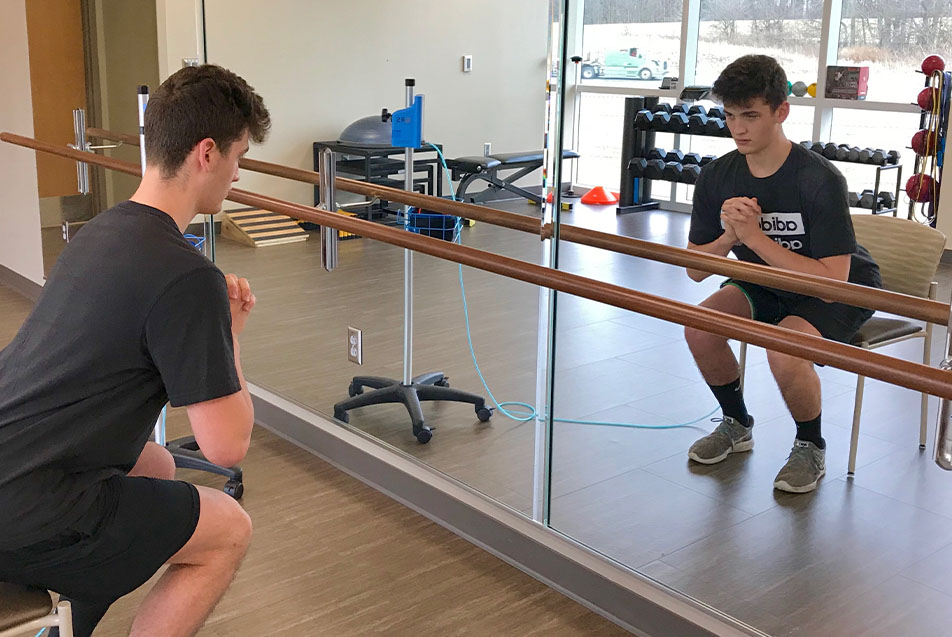
Parkview Huntington Hospital (PHH) therapists are excited by results they’re seeing from a new therapy offered to patients. Blood flow restriction (BFR) therapy is a technique that can provide significant benefit to rehab patients as well as performance gains for athletes.
The idea behind BFR is simple: Using a pressurized cuff, partially block blood flow to the muscles in an arm or leg to restrict the oxygen supply. The muscles experience metabolic stress, which triggers a reaction that, surprisingly, helps them grow in size and strength.
Huntington North High School senior Logan White has come to appreciate this cutting-edge therapy – because it has helped him recover following a catastrophic accident.
In October, White, a competitive cross country motorcycle racer, was out riding a local course to train for the upcoming season. The grandson of champion motorcycle racer Patrick “Pat” Flynn, White started out riding “minis” before he was 3 and began racing competitively by age 8. Now 18, and having grown up first watching Flynn race and then joining him on the cross country circuit, he lives for the sport.
Because speed and dirt trails can be a tricky combination, White says he is careful to take safety precautions. On that October day, he was kitted out in his usual protective gear – boots, pads, helmet, goggles, gloves, and a chest protector under his jersey – as he clipped along on his two-stroke KTM 250 motorcycle. As a friend came traveling back toward him from another part of the course, something went wrong, and the two bikes collided. The wheel of the friend’s motorcycle tore into White’s left leg, and the force of the impact threw White some 20 feet from his bike.
As White regained consciousness, he realized he was injured and bleeding. He had a nasty compound fracture of the tibia, the larger of the two lower-leg bones.
“I think I was full of adrenaline,” he said, “because I saw the bone sticking out of my leg and I reached down and put it back in by myself. The pain hadn’t hit me yet.”

Rushed to an area hospital along with his friend, who had life-threatening upper-leg injuries, White says the next few days were a blur. His leg was stabilized in preparation for major surgery the next day. A titanium rod was implanted to realign his knee and lower leg. Thirty-five staples closed his multiple incisions, and medication for pain was a must.
“I really think if I hadn’t had my motorcycle boots on, I would have lost my leg,” White said.
His surgeon told him he would need to be non-weight-bearing for a month. Rest and elevation was the prescription. Accustomed to being on the go, White was more than ready to get out of the house and start rehab by mid-November. Even on crutches, though, White still couldn’t be vertical for more than a few minutes at a time. The leg throbbed painfully and was still swollen.
Following his assessment for physical therapy at PHH, Katie Kaiser, rehab supervisor, and Dylan Hartman, physical therapy assistant, decided White was a good candidate for BFR. Both had received BFR training as part of their affiliation with Parkview Athletic Rehab, and in fact, all physical and occupational therapists at PHH’s Holly D. Sale Rehab and Wellness Center are trained in this new technique.
“Logan was still recovering from the surgery,” Hartman said, “and he was weak. He couldn’t even do the simplest exercises. A really traumatic injury like that can take a long time to heal. We felt BFR could speed up the process, and it definitely has – both in his regaining strength and just overall healing. People like him are perfect candidates for BFR, because they’re not weight-bearing. And that’s when you’re losing the muscle mass.”

BFR enables a patient with an injury to work muscles and promote tissue regeneration with low-intensity exercise or movement that puts little strain on compromised body parts. The technique has been tested in numerous studies around the world, Hartman said, and the results are “undeniable”.
Before exercise, White positions a stretchy sleeve around his thigh. The pressurized BFR cuff wraps over the sleeve, and a small monitor attached to the cuff inflates. It increases pressure to find a maximum level that completely blocks blood flow, then immediately cuts back to 80 percent of that maximum. The result is that tissues in the leg below the cuff receive only 20 percent of their normal blood flow and oxygen levels. During repetitions of a leg lift or other exercise, the muscles become stressed because they’re starved for oxygen. On the outside, the leg turns purple or darkens in color; inside, the muscles produce lactate, which increases growth hormone production and collagen development, ultimately building muscle fiber and strength and stimulating healing. Once exercise is halted, the leg returns to its regular color.
Hartman notes that while the initial use of the cuff can be uncomfortable, patients seem to adjust quickly. White agreed: “It’s well worth it, especially if you’ve had a traumatic injury like I have, or if you can’t use heavy weights. BFR is definitely a good treatment.”
For safety reasons, BFR is never used for more than 30 minutes at a time, and always under the supervision of trained personnel using specialized, FDA-approved equipment. During use, the patient takes short breaks between sets of repetitions to give the muscles a break.
BFR can be safe for people recovering from a variety of injuries or conditions, provided they are in generally good health. However, there are some conditions for which it is not appropriate, including severe high blood pressure, clotting disorders, active cancer, impaired circulation or peripheral vascular compromise, sickle cell anemia, open fracture or open soft tissue injury, or lymphectomy. It is not currently recommended for patients with diabetes, although more research is being done.
After two months, White is moving well and nearly done with his BFR therapy sessions, which encompass a variety of exercises done with ankle weights and resistance bands. He’s building strength in his hips, too, because he wants to return to track and, of course, motorcycle racing.
“Oh, yes, I plan to return to racing,” he said. “The season starts in two months, so I’ve still got time to get ready. I already had sponsors lined up for next season. And I just love it.”
We want to hear from you
Would you like to share your positive Parkview story? Submit your experience at parkview.com/shareyourstory.
This content previously appeared in the Huntington County TAB.



